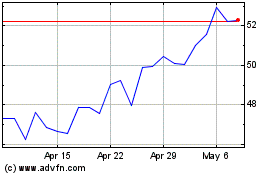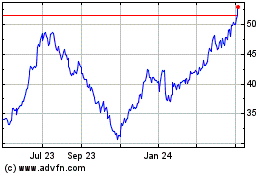By Brianna Abbott
Amid the fast-moving, novel coronavirus outbreak emanating from
China, companies, governments and schools are developing policies
on the fly to try to halt the spread, creating a live global
public-health experiment in containment.
In the U.S., some businesses and universities have told people
who had recently returned from the epicenter of the outbreak or
from mainland China to stay home for as long as two weeks after
returning. The U.S. government also said on Friday that it would
deny entry to foreign citizens who had traveled to China within the
past 14 days and imposed a maximum two-week quarantine on Americans
returning from Hubei province where the outbreak started. Major
airlines, including Delta Air Lines Inc. and American Airlines
Group, said they would stop all flights to mainland China, with
other airlines cutting back on services. The State Department
issued a "Do Not Travel" alert, the highest warning level, urging
citizens not to travel to China.
Public-health experts say that the risk of infection is low in
the U.S. for the general public, but precautions are warranted
given how little is known about the virus, which emerged in Hubei
province's capital city of Wuhan only a few weeks ago and has yet
to be contained. Travel bans have limited effectiveness at this
point in the outbreak and come with their own set of consequences,
and public-health authorities are working to balance controlling
the virus against repercussions on economics, social relationships
and individual liberties.
"We're in a phase where a lot is unknown, and that makes it
scary, and there might be a tendency to a strong reaction until
more is learned," said Mark Mulligan, the director of NYU Langone
Health's division of infectious diseases and immunology. "It's not
a time for panic or overreaction but to follow the playbook."
Two-week quarantines and restrictions on returning to work are
based on concerns that people may be able to spread the virus
during the so-called incubation period when they are infected but
not yet showing symptoms. Right now, the estimates by
epidemiologists range anywhere from two days to two weeks, largely
based on what scientists know about other coronaviruses. Experts
are erring on the side of caution by recommending the upper end of
that 14-day period for monitoring and quarantines, health experts
say.
Scientists don't know the full timeline of when people are
infectious. At least one report, published in the New England
Journal of Medicine, describes a patient in Germany passing along
the virus before developing symptoms, and a bus driver in Japan
recently tested positive for the virus after driving tourists from
Wuhan, none of whom had shown severe symptoms. The World Health
Organization says that most of the transmission has occurred in
symptomatic patients and that passing along the virus before a
patient has developed symptoms is rare but possible.
Outright travel bans might have come too late to fully stop the
contagion, some experts say. "At this point, the cows are out of
the barn," said Michael Osterholm, director of the University of
Minnesota's center for infectious disease research and policy. "To
think that we're going to stop it by ending travel is not at all
practical."
Global health authorities are warning countries and hospitals to
prepare for containment and prevention of the virus within their
borders, and encouraging them to engage in international
cooperation to help countries with weaker health systems.
Surveillance, tracking and monitoring, isolating sick people and
even quarantining certain individuals are likely reasonable or
necessary from a public health standpoint to halt the
fast-spreading virus, experts say.
The novel outbreak that originated in China in December has now
spread to at least 23 other countries, with over 17,000 confirmed
cases and more than 300 deaths. Most of the cases and deaths have
been in China. The first death outside of China, a 44-year-old man
in the Philippines from Wuhan, occurred Saturday, according to the
Philippine Department of Health.
Just 11 people in the U.S. have been confirmed with the virus,
and all but two had recent travel history to Wuhan. Public-health
authorities are intent on preventing further human-to-human spread
in the U.S. and delaying the entry of the virus into the
country.
The novel coronavirus doesn't appear to be as contagious as the
measles or as deadly as SARS or MERS, also coronaviruses that
killed 10% and roughly one-third of infected people, respectively.
But it does seem fast-moving and deadlier than seasonal influenza,
which has infected at least 19 million people and killed 10,000 in
the U.S. so far this season, according to estimates from the
Centers for Disease Control and Prevention.
In the absence of a vaccine, some public-health experts worry
that the pathogen might be able to continuously circulate
throughout the country, akin to a seasonal virus. The goal of the
U.S. public-health response is to prevent sustained spread,
according to the CDC, though the agency says it expects more cases
and even human-to-human transmission.
"We either stop it now or we never stop it," said Lawrence
Gostin, the director of the O'Neill Institute for National and
Global Health Law at Georgetown University. "We have to be prepared
for the possibility that this is going to be like the seasonal
flu."
Health experts also note that some policies could go too far.
More than 60% of all confirmed cases are just in Hubei province, so
quarantining or banning anyone returning to the U.S. from all of
mainland China is an overreach, said Mr. Gostin, who is also the
director of the WHO Collaborating Center on National and Global
Health Law. Airport screening or monitoring them for symptoms would
have likely sufficed, he said.
Travel bans also often discourage international cooperation and
have social and economic consequences that some experts say can
damage the public-health response, especially if countries become
more secretive about their case numbers to avoid travel and trade
repercussions.
Others, however, say it makes sense that airlines would want to
avoid putting their employees in danger and that countries want to
protect their own citizens.
"At the start of an outbreak, there's a fog of war," said Nathan
Grubaugh, an assistant professor of epidemiology at the Yale School
of Public Health. "You're trying to weigh two bad choices to figure
out which is worse, and I think in this case, limited travel and
trade is worse."
When the WHO declared the coronavirus a public health emergency
of international concern last week, officials explicitly said that
the agency was against any trade and travel restrictions put on
China, such as visa refusal or border closure. But the next day,
the Trump administration announced its increased travel
restrictions, which then got pushback from Chinese officials.
Public-health experts also expressed concern about unnecessary
worry and misinformation circulating in the U.S., including
discrimination and xenophobia against Chinese residents or even
Asian Americans who have never been to China, said Dr.
Grubaugh.
Within the U.S., public-health experts note that the virus isn't
an immediate risk to the general public, and the CDC currently
recommends against actions like wearing face masks.
"If you happen to walk down the street and pass someone with the
virus, you're not going to catch it from them," said Robert
Citronberg, an infectious-disease specialist at Advocate Health
Care in Illinois. Instead, health authorities are attempting to
turn fears over the novel coronavirus into action against a more
immediate threat: "A lot of people who are concerned about the
coronavirus haven't even gotten a flu shot," he said.
Write to Brianna Abbott at brianna.abbott@wsj.com
(END) Dow Jones Newswires
February 03, 2020 13:49 ET (18:49 GMT)
Copyright (c) 2020 Dow Jones & Company, Inc.
Delta Air Lines (NYSE:DAL)
Historical Stock Chart
From Mar 2024 to Apr 2024

Delta Air Lines (NYSE:DAL)
Historical Stock Chart
From Apr 2023 to Apr 2024
